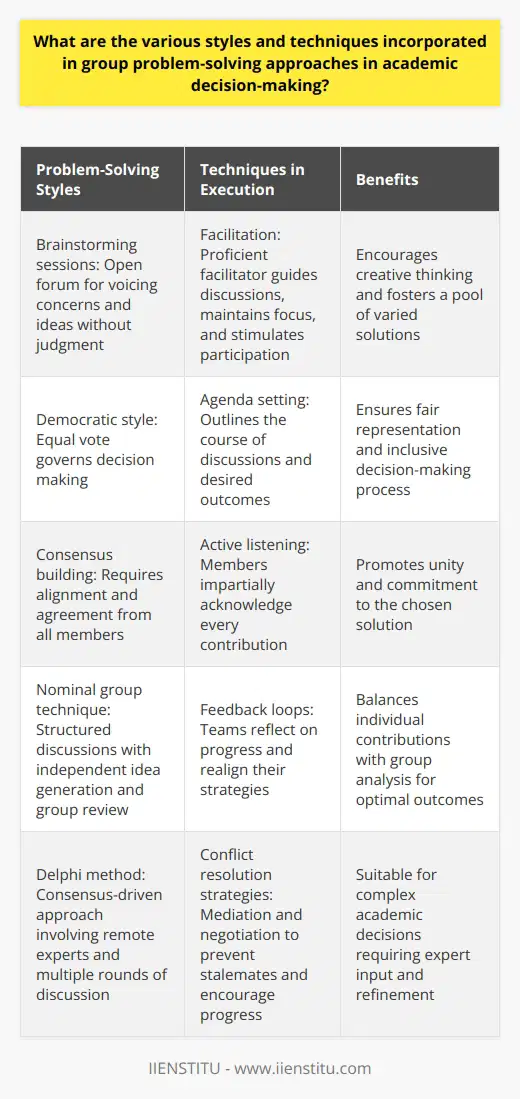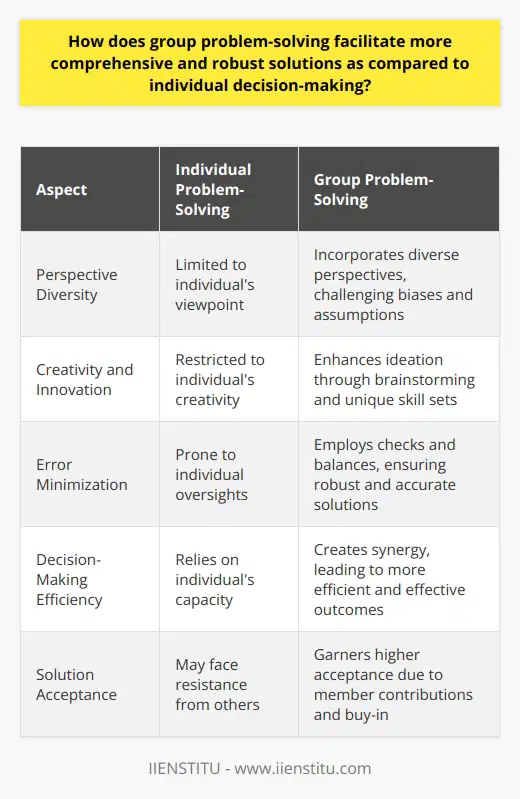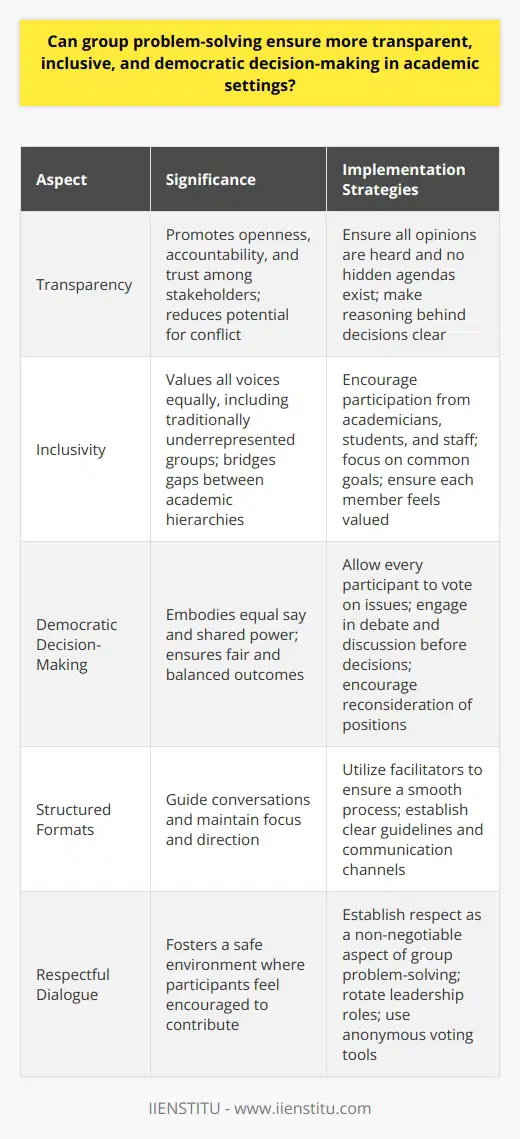
In today's fast-paced and complex world, the ability to effectively solve problems as a group has become an essential skill. Whether you're working in a corporate setting, a non-profit organization, or an educational institution, group problem solving can help you tackle challenges more efficiently and effectively. In this comprehensive guide, we'll explore the key aspects of group problem solving, including its benefits, challenges, and best practices.
The Importance of Group Problem Solving
Group problem solving is a critical skill that can benefit individuals and organizations in many ways. Here are some of the key reasons why group problem solving is so important:
Diverse Perspectives
One of the biggest advantages of group problem solving is that it brings together a diverse range of perspectives and experiences. When you have multiple people working together to solve a problem, you can tap into a wider range of knowledge, skills, and ideas. This can lead to more creative and innovative solutions that might not have been possible with just one person working alone.
I remember a time when I was working on a project with a team of colleagues from different departments. We were tasked with finding a way to reduce costs while maintaining quality. At first, it seemed like an impossible task, but as we started brainstorming and sharing our ideas, we realized that we each had unique insights and experiences that could help us find a solution. By working together and leveraging our diverse perspectives, we were able to come up with a plan that not only reduced costs but also improved the overall quality of our product.
Increased Efficiency
Another benefit of group problem solving is that it can help you solve problems more efficiently. When you have multiple people working together, you can divide tasks and responsibilities, which can help you get things done faster. Additionally, group problem solving can help you avoid duplication of effort and ensure that everyone is working towards the same goal.
I once worked on a project where we had a tight deadline and a lot of work to do. Instead of trying to tackle everything on our own, we decided to divide the work among the team members based on their strengths and expertise. By working together and leveraging each other's skills, we were able to complete the project on time and with high quality.
Improved Decision Making
Group problem solving can also lead to better decision making. When you have multiple people involved in the decision-making process, you can consider a wider range of options and perspectives. This can help you make more informed and well-rounded decisions that take into account the needs and concerns of all stakeholders.
I remember a time when our team was trying to decide whether to launch a new product line. We had a lot of conflicting opinions and concerns, but by working together and considering all the different perspectives, we were able to make a decision that was in the best interest of the company and our customers.
Challenges of Group Problem Solving
While group problem solving can be incredibly beneficial, it's not without its challenges. Here are some of the common challenges that teams face when trying to solve problems together:
Groupthink
One of the biggest challenges of group problem solving is the risk of groupthink. Groupthink occurs when the desire for harmony and consensus within the group overrides critical thinking and individual opinions. This can lead to poor decision making and a lack of creativity.
To avoid groupthink, it's important to encourage open and honest communication within the group. Leaders should create an environment where everyone feels comfortable sharing their ideas and opinions, even if they differ from the majority. It's also important to actively seek out dissenting opinions and encourage constructive debate.
Lack of Participation
Another common challenge of group problem solving is lack of participation. Sometimes, certain members of the group may dominate the conversation, while others remain silent. This can lead to a lack of diverse perspectives and ideas, which can hinder the problem-solving process.
To encourage participation from all members of the group, leaders should create a safe and inclusive environment where everyone feels valued and heard. This may involve using facilitation techniques like round-robin discussions or small group breakouts to ensure that everyone has a chance to contribute.
Conflict
Conflict is another common challenge that can arise during group problem solving. When people with different personalities, communication styles, and opinions come together, it's natural for disagreements to occur. However, if not managed properly, conflict can lead to a breakdown in communication and collaboration.
To manage conflict effectively, it's important to establish clear ground rules and expectations for behavior. Leaders should also model active listening and respectful communication, and encourage team members to do the same. When conflicts do arise, it's important to address them directly and work towards finding a mutually beneficial solution.
Best Practices for Effective Group Problem Solving
Now that we've explored some of the benefits and challenges of group problem solving, let's take a look at some best practices for making the most of this powerful tool.
Define the Problem Clearly
Before you start brainstorming solutions, it's important to clearly define the problem you're trying to solve. This may involve gathering data, analyzing the root causes of the problem, and identifying the key stakeholders involved.
I once worked on a project where we were trying to improve customer satisfaction, but we didn't have a clear understanding of what was causing the dissatisfaction in the first place. By taking the time to gather feedback from customers and analyze the data, we were able to identify the specific pain points that needed to be addressed. This helped us focus our problem-solving efforts and come up with more targeted solutions.
Encourage Diverse Perspectives
As we mentioned earlier, one of the biggest benefits of group problem solving is the ability to tap into diverse perspectives and ideas. To make the most of this benefit, it's important to actively encourage and seek out different viewpoints.
This may involve bringing in people from different departments or backgrounds, or using techniques like brainstorming or mind mapping to generate a wide range of ideas. It's also important to create an environment where everyone feels comfortable sharing their thoughts and opinions, even if they differ from the majority.
Use a Structured Problem-Solving Process
To ensure that your group problem-solving efforts are effective and efficient, it's important to use a structured problem-solving process. This may involve using tools like the Six Sigma DMAIC (Define, Measure, Analyze, Improve, Control) methodology or the Design Thinking process.
Using a structured process can help you stay focused and organized, and ensure that you're considering all the relevant factors and stakeholders involved. It can also help you track your progress and measure the effectiveness of your solutions over time.
Communicate Effectively
Effective communication is key to successful group problem solving. This involves not only sharing your own ideas and opinions, but also actively listening to others and seeking to understand their perspectives.
To communicate effectively, it's important to use clear and concise language, avoid jargon or technical terms that may be unfamiliar to others, and ask questions to clarify understanding. It's also important to be open to feedback and willing to adjust your communication style as needed to ensure that everyone is on the same page.
Celebrate Successes and Learn from Failures
Finally, it's important to celebrate your successes and learn from your failures. When your group successfully solves a problem or achieves a goal, take the time to acknowledge and celebrate your accomplishments. This can help build morale and motivation, and reinforce the value of collaboration and teamwork.
At the same time, it's important to view failures as opportunities for learning and growth. When something doesn't go as planned, take the time to analyze what went wrong and identify areas for improvement. Use this knowledge to inform your future problem-solving efforts and continue to refine your skills and processes over time.
Conclusion
Group problem solving is a powerful tool that can help individuals and organizations tackle complex challenges and achieve their goals more effectively. By bringing together diverse perspectives, increasing efficiency, and improving decision making, group problem solving can lead to more creative and innovative solutions that might not have been possible with just one person working alone.
Of course, group problem solving is not without its challenges, including the risk of groupthink, lack of participation, and conflict. However, by using best practices like defining the problem clearly, encouraging diverse perspectives, using a structured problem-solving process, communicating effectively, and celebrating successes and learning from failures, you can overcome these challenges and make the most of this valuable tool.
Whether you're a seasoned problem solver or just starting out, there are many resources available to help you improve your skills and knowledge in this area. From problem solving training programs to online certificate courses, there are plenty of opportunities to learn and grow as a problem solver.
So the next time you're faced with a complex challenge, don't go it alone. Bring together a diverse group of people, leverage their unique perspectives and experiences, and work together to find a solution that works for everyone. With the power of group problem solving on your side, there's no limit to what you can achieve.
Frequently Asked Questions
What are the various styles and techniques incorporated in group problem-solving approaches in academic decision-making?
Group Problem-Solving in Academia
Styles in Problem-Solving
Academic environments often nurture diverse approaches. Group problem-solving marks a pivotal aspect. Collectively, multiple perspectives unite, leading to enriched outcomes. Teams engage in brainstorming sessions initially. Here, participants voice concerns and ideas without judgment. An open forum encourages creative thinking, fostering a pool of varied solutions. A democratic style follows, where equal vote governs decision making. Consensus building serves as another approach. This requires alignment and agreement from all members.
The nominal group technique stands distinct. It introduces structure to discussions. Participants write down ideas independently. Group review of these concepts follows. Delphi method, aimed at consensus, involves experts who operate remotely. Several rounds of discussion refine ideas and elicit agreement. Complex academic decisions often warrant this method.
Affinity grouping surfaces as a technique to organize ideas. Similar concepts cluster, promoting clarity and focus.
Techniques in Execution
Implementing these styles demands meticulous techniques. Facilitation leads such efforts. A proficient facilitator guides discussions, maintains focus, and stimulates participation. Clear agenda setting matters greatly. It outlines the course of discussions and desired outcomes. Ensuring an inclusive environment requires active listening. Members must impartially acknowledge every contribution.
Regular feedback loops enhance effectiveness. Teams reflect on progress and realign their strategies.
Effective problem-solving embraces conflict resolution strategies. These include mediation and negotiation. Skills in these areas prevent stalemates and encourage progress.
Visualization tools often play an integral role. Diagrams and mind maps illuminate relationships and patterns.
Data-driven decision making in academia cannot be overstated. Quantitative and qualitative data inform choices, provided via surveys or institutional research.
Finally, reflection and evaluation cap the process. Assessing decisions against set goals ensures learning and improvement. Continual evaluation refines group problem-solving over time.
Conclusion
Academic decision-making blossoms with varied styles and techniques. Embracing these enriches the problem-solving process. It strikes a balance between collaborative creativity and structured analysis. Tailoring the approach to the problem in hand remains crucial. Schools invest in training to equip staff with necessary skills. The goal: effective, inclusive, and informed decisions that project academic institutions forward.

How does group problem-solving facilitate more comprehensive and robust solutions as compared to individual decision-making?
Group Problem-Solving: A Multi-Faceted Approach
In group problem-solving, a blend of perspectives emerges. Diverse viewpoints foster comprehensive analysis. They challenge individual biases and assumptions. This collaboration often unveils overlooked aspects of a problem.
Enhanced Creativity and Innovation
Ideation thrives in collaborative settings. Multiple brains generate more ideas than one. This brainstorming yields creative and innovative solutions. Each member brings a unique set of skills and experiences.
Error Minimization
Groups can catch errors an individual might miss. This process of checks and balances ensures robust solutions. Moreover, members hold each other accountable. As a result, the group maintains a high standard of accuracy.
Synergy in Decision-Making
Collaboration creates synergy. Together, members achieve more than they could alone. This synergy produces efficient and effective solutions. It is the hallmark of successful group problem-solving.
Increased Acceptance of Solutions
Group decisions often see higher acceptance rates. Why? Because members contribute to the solution. They are more likely to support outcomes they helped create. This buy-in is critical for implementation and success.
Resource Pooling
Groups pool resources and competencies. This union allows for more complex problem analysis. It enables tackling problems from various angles. Consequently, the solutions are usually more robust.
Skill Enhancement and Learning
Group problem-solving provides learning opportunities. Members learn from each other’s expertise. They refine their problem-solving skills. This continuous learning fosters a culture of improvement and innovation.
Morale Boost and Support
Groups offer moral support. They create a sense of belonging and community. Members facing tough problems benefit from shared experiences. This support boosts morale and motivation.
In conclusion, group problem-solving outshines solitary decision-making. It creates solutions that are innovative, well-vetted, and broadly supported. This advantage underscores the power of collaborative effort in confronting challenges.

Can group problem-solving ensure more transparent, inclusive, and democratic decision-making in academic settings?
Group Problem-Solving in Academic Settings
Group problem-solving stands as an essential approach. It fosters transparency in decision-making. Participants come from diverse backgrounds. They bring unique perspectives. This inclusivity enriches the decision-making process.
The Essence of Transparency
Transparency implies openness. It conveys accountability. Everyone understands the reasoning behind decisions. This clarity reduces conflict potential. It promotes trust among stakeholders.
Group problem-solving lays bare all opinions. It allows no hidden agendas. Each participant voices concerns freely. They share thoughts without reservations. Thus, decisions reflect collective agreement.
Inclusivity: Expanding the Table
Inclusivity means wider representation. It values all voices equally. Traditionally underrepresented groups get a say. This policy enriches academic decision-making. It bridges the gap between different academic hierarchies.
Academicians, students, and staff participate together. They focus on common goals. The variety of insights leads to comprehensive solutions. Each member feels valued. This results in committed adherence to decisions.
Democratic Decision-Making
Democratic refers to equal say. It suggests shared power. Group problem-solving embodies this principle. Every participant votes on issues. Majorities help determine outcomes.
Debate and discussions proceed before decisions. They encourage participants to reconsider positions. Everyone grasps the rationales of differing views. The process ensures fair and balanced outcomes.
Implementing Group Problem-Solving
Structured Formats are vital. They guide the conversation. Facilitators ensure a smooth process. They help maintain focus and direction.
Respectful Dialogue is non-negotiable. Respect fosters a safe environment. Participants feel encouraged to contribute.
Challenges and Solutions
Challenges exist within group problem-solving. They include groupthink risks. Also, dominant voices can overshadow others. Mitigation strategies involve clear guidelines and strong facilitation.
- Rotate leadership roles.
- Use anonymous voting tools.
- Establish clear, accessible communication channels.
Conclusion
Group problem-solving can indeed ensure transparency, inclusivity, and democracy. It requires careful planning and an intentional approach. The rewards include better decision-making. Those decisions serve the academic community more effectively.



